The secret history of the Pyramids of Giza will astonish you
- Oops!Something went wrong.Please try again later.
Wonder of the world
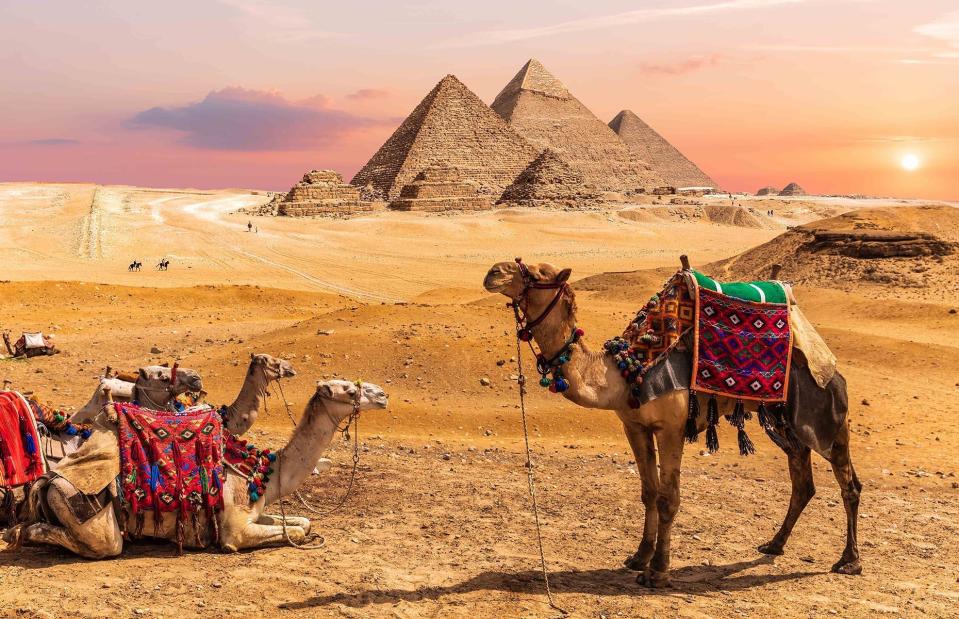
AlexAnton/Shutterstock
Egyptologists occasionally cite an old Arab proverb: "man fears time, and time fears the pyramids". Surely among the best-known buildings in the whole of human history, the Pyramids of Giza are some of the world's oldest and largest ancient structures, and are still so steeped in mystery that we can't even be completely sure how they were built.
From their construction by some of Egypt's earliest pharaohs to their status as superstars of modern-day tourism, read on to learn the staggering stories behind the Pyramids of Giza...
The pyramids are very, very, very old
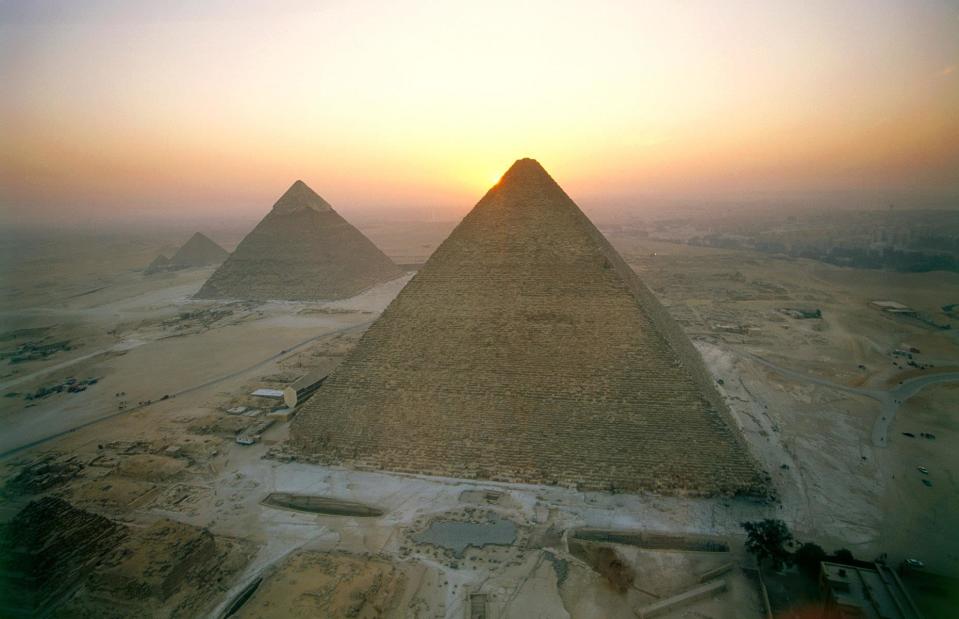
Duby Tal/Albatross/Alamy Stock Photo
Everyone knows the Pyramids of Giza are old, but seriously – they're really, really old. Built around 2500 BC, they predate Tutankhamun by around 1,200 years and had been standing for roughly two millennia by the birth of the Roman Republic.
The present day is closer in time to the reign of Egypt's final pharaoh Cleopatra, and her romance with Mark Antony, than Cleopatra is to the construction of the pyramids. When Egyptian masons were erecting the first limestone blocks in the Giza desert, woolly mammoths still roamed the Earth.
They've witnessed most of human history
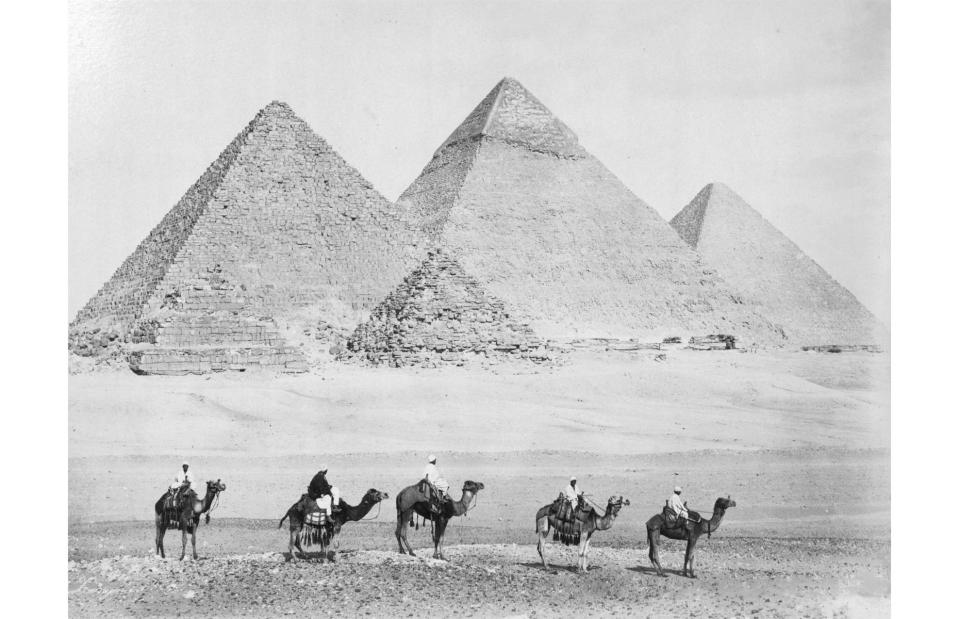
GL Archive/Alamy Stock Photo
Many ancient sites were lost before they were found, spending centuries hidden underground or guarded by impenetrable jungle, forgotten by all but a handful of locals. The Roman city of Pompeii, China's terracotta warriors and the citadel of Machu Picchu have all spent most of their existence out of the public eye, and all three were 'rediscovered' by modern archaeology and exploration.
It's pretty hard to lose track of three enormous stone triangles surrounded by desert, and the pyramids have enjoyed some level of fame for every one of their 4,500 years.
The Great Pyramid was the tallest structure in the world for 3,800 years
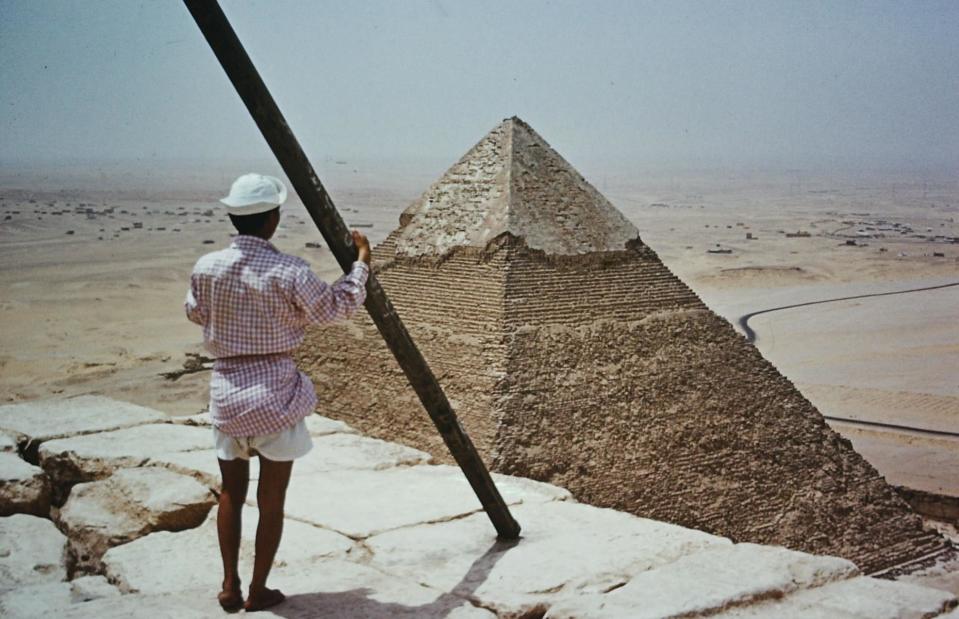
Lorenz.King at JLU Giessen.de/Wikimedia Commons/CC BY-SA 4.0
Holding down a world record for any length of time is pretty good going, but if the Guinness Book of Records had existed in 2500 BC, it would have honoured the Great Pyramid in every subsequent edition for nearly four millennia. The 481-foot (147m) monument was the world's tallest structure until it was overtaken by Lincoln Cathedral in 1311 – 'structure' because, since it was never habitable, it doesn't qualify as a 'building'.
The cathedral clung onto the record for 238 years, the Empire State Building managed almost four decades through the middle of the 20th century, and the Burj Khalifa is on 13 years so far.
It's also the only wonder of the ancient world left standing

AMIR MAKAR/AFP via Getty Images
Of the so-called Seven Wonders of the Ancient World, only the Great Pyramid remains. The Colossus of Rhodes, the Mausoleum of Halicarnassus and the Lighthouse of Alexandria were likely levelled by earthquakes; the Temple of Artemis was ravaged by fire while the Olympian Statue of Zeus was likely burnt after being removed to Constantinople.
As for the Hanging Gardens of Babylon, scholars still argue late into the night over whether they existed at all. Only the Great Pyramid of Giza has survived: it predated the other wonders by almost two millennia, and has outlived them by five centuries and counting.
There's the Khufu Pyramid...
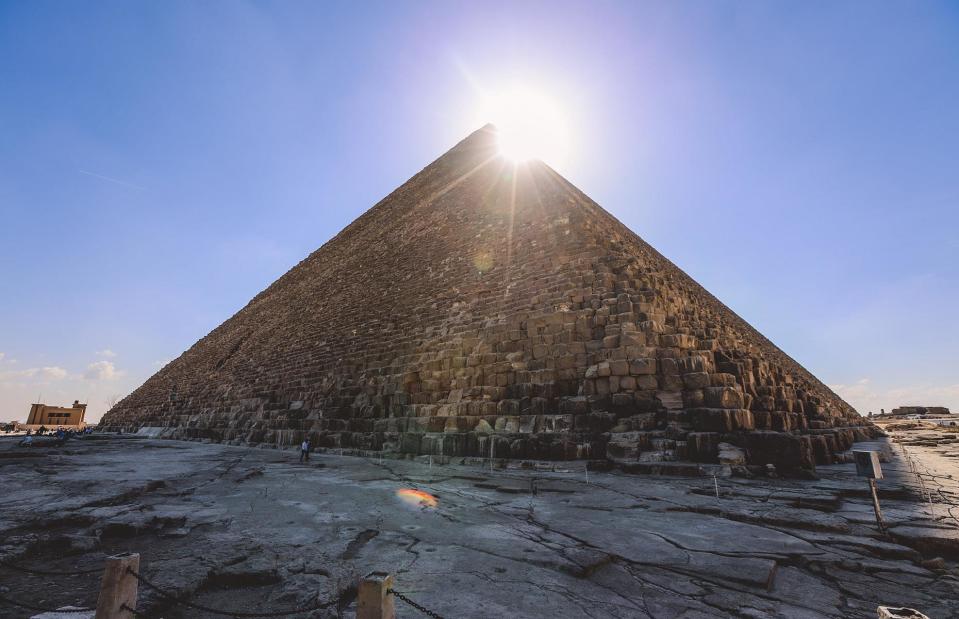
Dave Primov/Shutterstock
The Great Pyramid is also known as the Khufu Pyramid. Arguably the most famous historic site in the world, it's the largest and earliest of the three main pyramids of the Giza complex, now clocking in at 455 feet (138m) tall and roughly six million tonnes in weight. Built for 4th-dynasty pharaoh Khufu to be his tomb, the pyramid was completed around 2560 BC and covers more than 13 acres.
The Great Pyramid marked the high point of Egyptian pyramid-building, but it was designed using the accumulated knowledge of pyramids past. Egypt's oldest pyramid is Saqqara's Step Pyramid (or the Pyramid of Djoser), which was finished around 2650 BC, and cascades in six distinct tiers.
...the Khafre Pyramid...
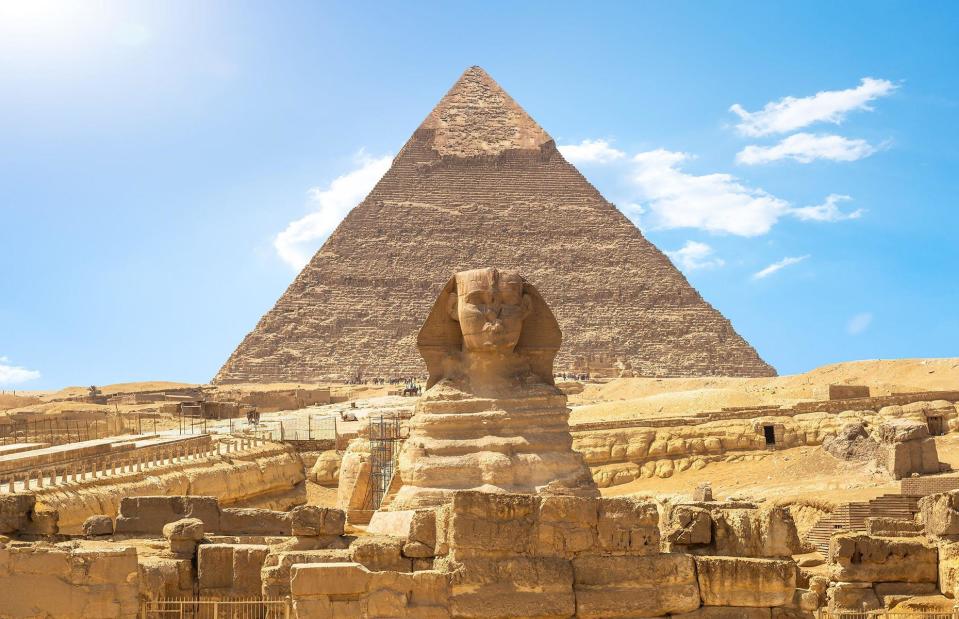
zevana/Shutterstock
The Khafre Pyramid is the second-largest of the three – named after and built for Khufu's son Khafre – and sits photogenically behind the Great Sphinx. At 446 feet (136m) the pyramid is just a few feet shy of the Great Pyramid, and looks taller to the naked eye as it sits on higher ground.
Inside, however, the pyramid is far less elaborate, with two entrances leading to a burial chamber that was robbed of its riches millennia ago. A 14th-century earthquake stripped away some of the structure's outer stones, but at its tip the pyramid retains some of its original white-limestone casing – the only one of the three that does.
...and the Menkaure Pyramid
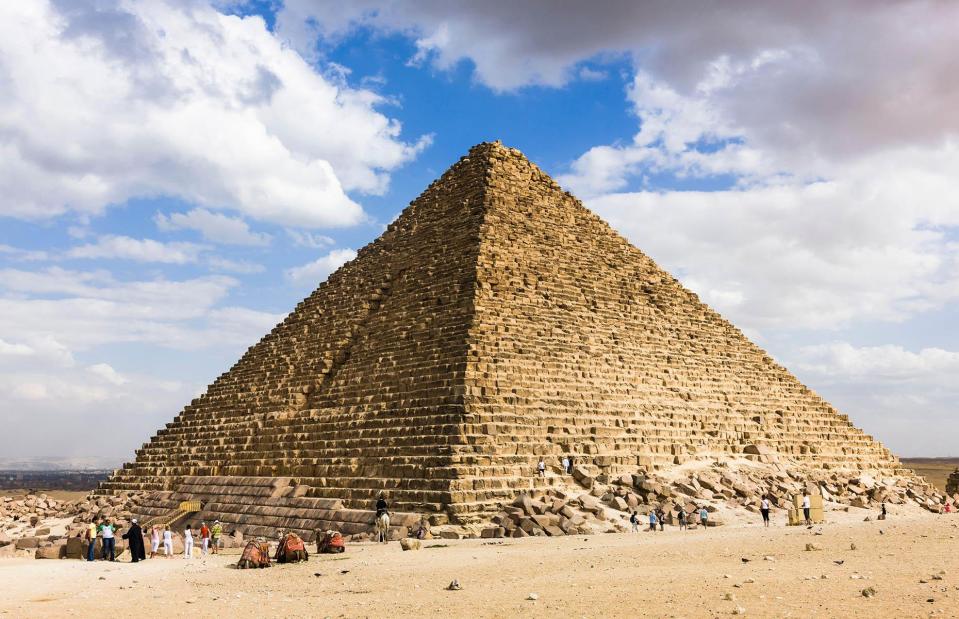
Suzuki Kaku/Alamy Stock Photo
Dwarfed by its two older siblings, the Menkaure Pyramid measures a mere 215 feet (63m). Built for Menkaure, son of Khafre and grandson of Khufu, the unfinished granite casing around the pyramid's entrance suggests that the pharaoh died before it was complete.
Menkaure's three-tonne stone sarcophagus was found inside the pyramid in 1837 by British adventurer and Egyptologist Howard Vyse, who had it removed from its resting place and loaded onto a ship bound for London's British Museum. The ship promptly sank somewhere in the western Mediterranean, entombing the sarcophagus once again, this time beneath the waves.
We're still not totally sure how they were built
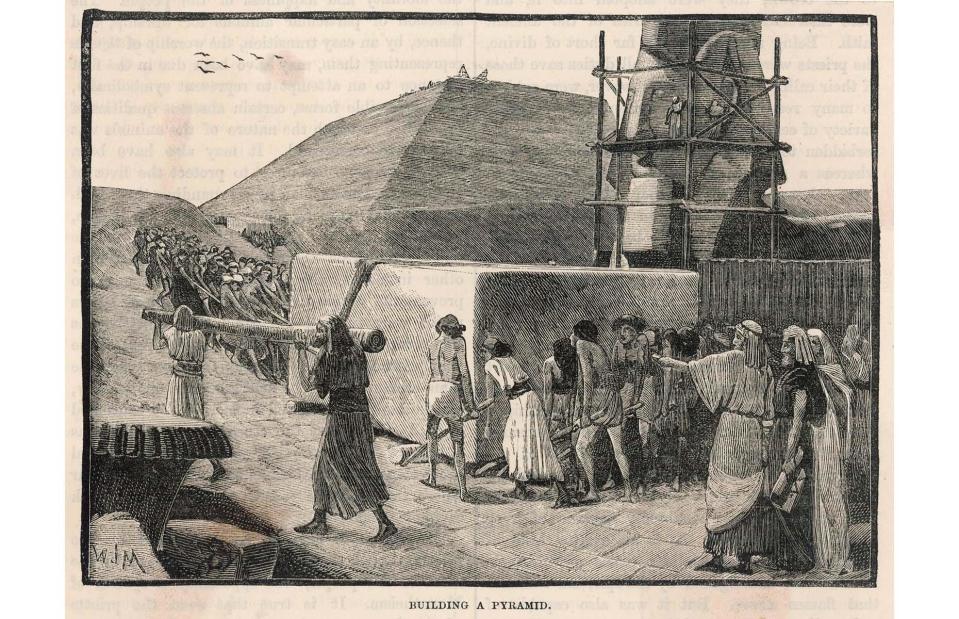
Chronicle/Alamy Stock Photo
Built with roughly 2.3 million blocks each weighing between two and 15 tonnes, the Great Pyramid represents an extraordinary feat for a civilisation that mostly lived in huts made of reeds and mud. The debate over how the pyramids were constructed has raged for centuries, and discredited theories range from concrete casts and lost vibration technology to ancient aliens.
Current consensus is a little more mundane: a series of external ramps that rose up alongside the pyramid, and blocks hauled up by a series of rollers, sledges and levers.
They're architecturally extremely advanced
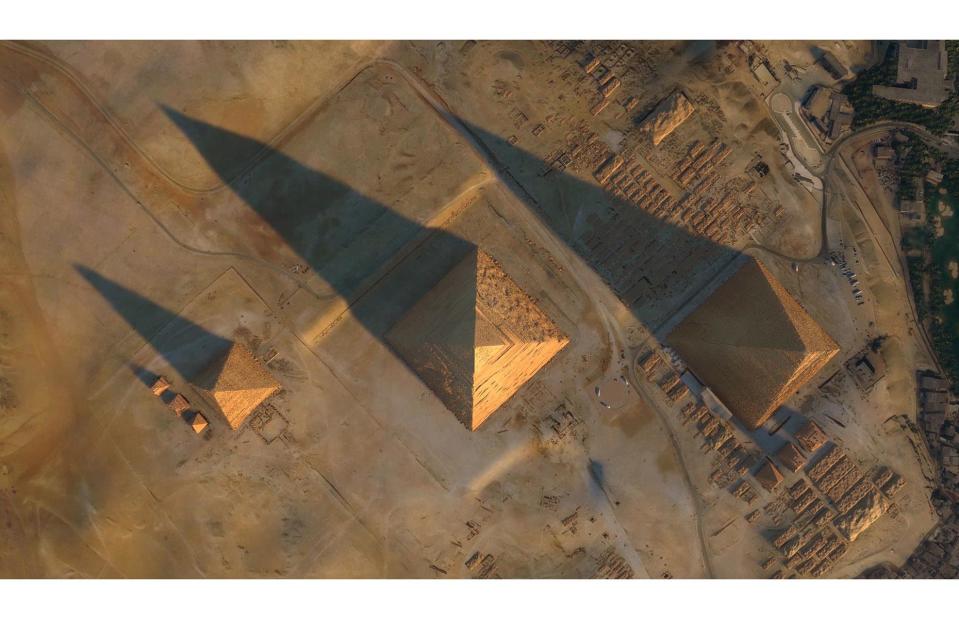
GLF Media/Shutterstock
An astonishing monument to human ingenuity, the pyramids are as mathematically astute as they are spectacular. The sides of the Great Pyramid are almost exactly aligned with the points of the compass – and the Khafre and Menkaure pyramids are not far off.
The Great Pyramid's base is also level to within a couple of centimetres, and its sides are just 15 centimetres or so from being a perfect square. Exactly how the Egyptians achieved such precision is a matter of debate.
But one thing above all stands as testament to the pyramids' engineering: they're still there.
There are many, many other tombs around the pyramids
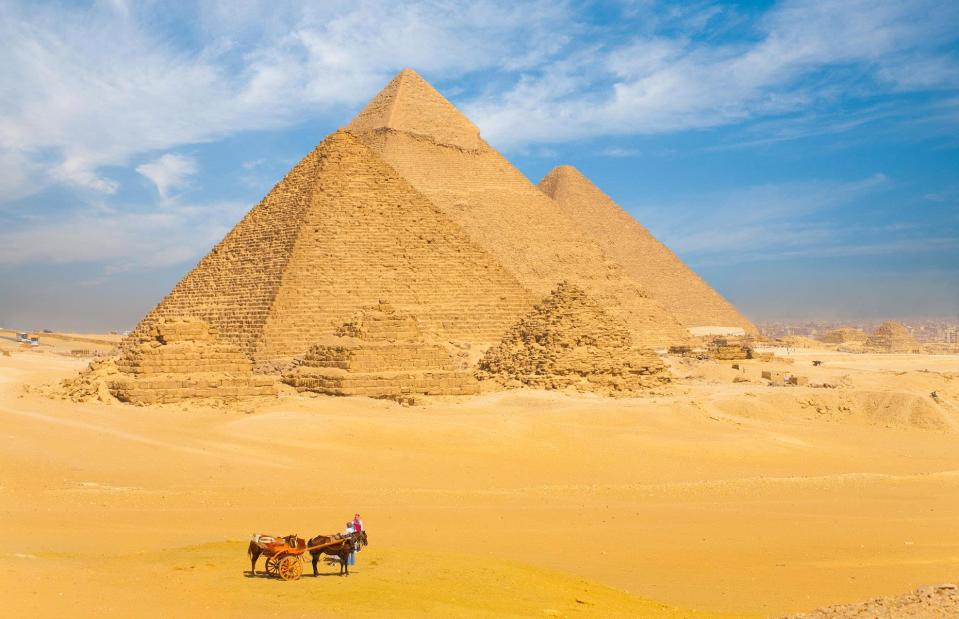
Zoonar GmbH/Alamy Stock Photo
The skyline-dominating pyramids naturally command most visitor attention, but they're just the centrepieces of a sprawling network of temples and tombs. The Khufu and Menkaure pyramids are rimmed by a trio of smaller pyramids each (pictured), often camouflaged against their sandy-brown neighbours, which were probably the tombs of the pharaohs' wives and relatives.
In the surrounding sand, excavations revealed sealed pits containing magnificent grave goods – most notably an almost-intact 144-foot-long (44m) wooden ship. Interred in honour of Khufu, the buried boat is one of the oldest planked vessels ever discovered.
They weren't built by slaves
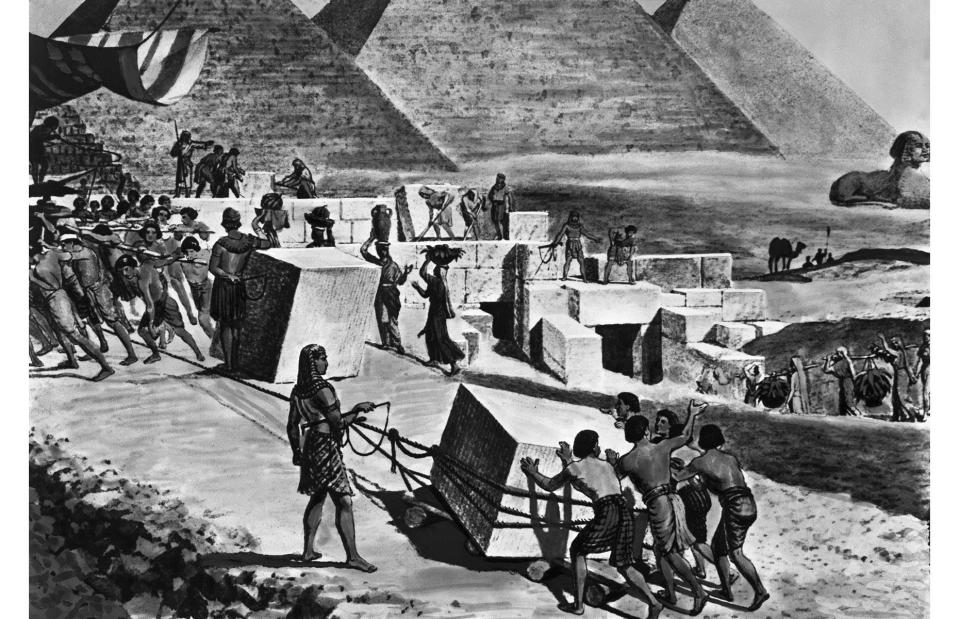
Bettmann/Getty Images
It was long assumed that slaves performed the extraordinary physical exertions that built the pyramids block by block, and the ancient Egyptians were certainly no strangers to slavery. But most modern scholars agree that the pyramids were built by paid craftsmen and labourers – perhaps farmers employed by the pharaoh during the months they could not work the land.
A large purpose-built village discovered near the site contains the remains of dormitories for rotating groups of workers, with evidence that they were eating prime cuts of meat. In and around the purpose-built village were some of their tombs, which were well-furnished with afterlife supplies.
Slaves could never expect such amenities; pyramid-building was clearly a respectable profession.
The pyramids' interiors are eerie but unspectacular
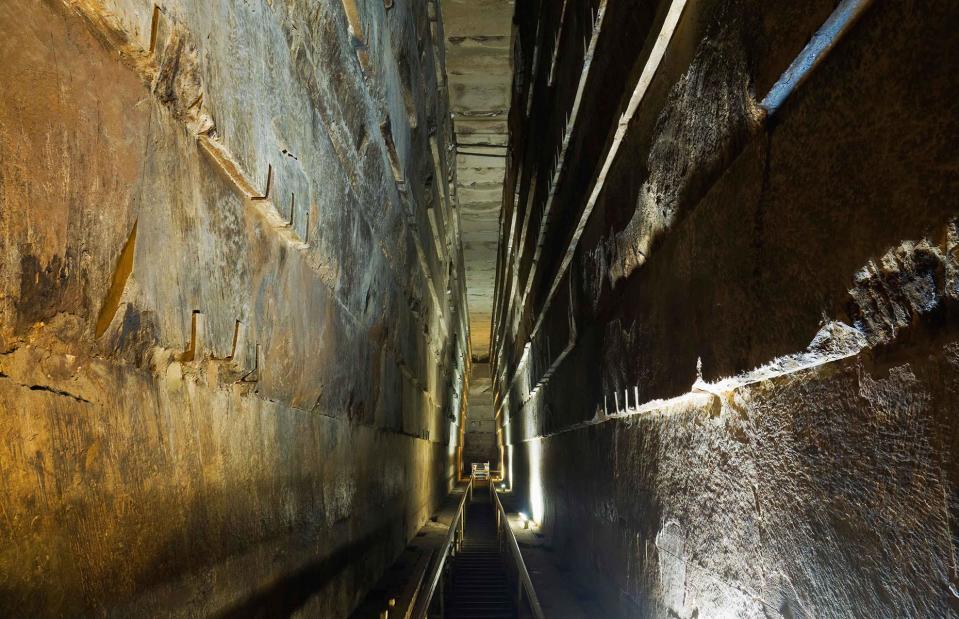
robertharding/Alamy Stock Photo
It's tempting to think of the pyramids as sprawling labyrinths, full of mysterious ritual spaces and Indiana Jones-esque booby traps. In reality the pyramids were meant to be sealed for all time, so their interiors were disappointingly simple – a few passageways, a main burial chamber and an awful lot of solid stone.
Of Giza's main monuments the Great Pyramid has the most interesting floor plan, with three distinct chambers, two of which are of unknown purpose. By far its most photogenic feature is the so-called 'grand gallery' – a long, narrow, extremely high-ceilinged corridor that leads to the central King's Chamber.
The pyramids once looked very different
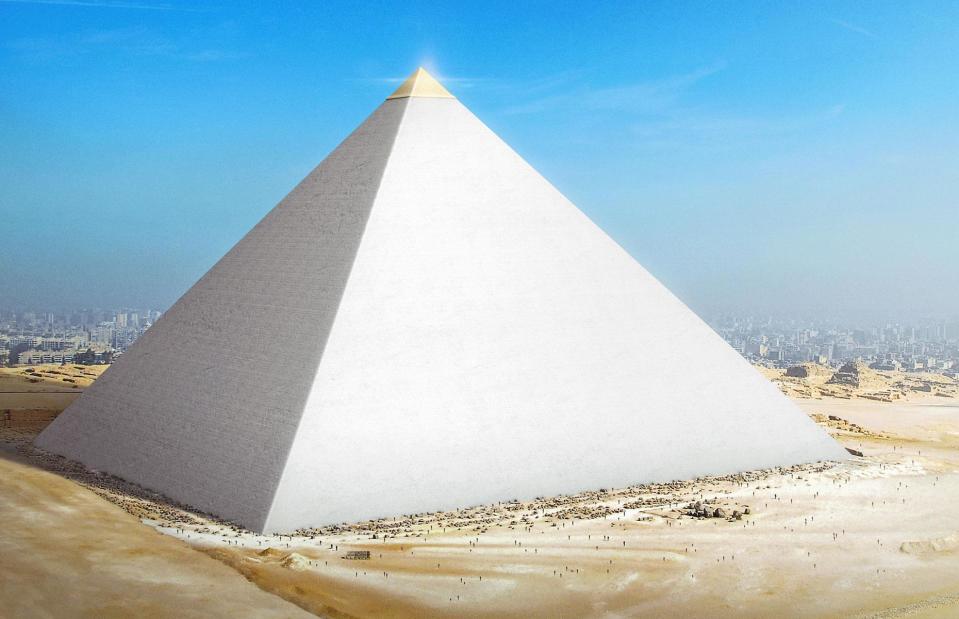
Courtesy of Budget Direct
These days it's easy to imagine that the ancient world was cast entirely from white marble and sandy-brown stone, but most ancient ruins would once have been decorated with vibrant colours. In their heyday the Pyramids of Giza were encased in a layer of white limestone that would have shone dazzlingly bright under the Egyptian sun.
They may also have been topped with golden 'capstones' that would have sparkled even more vividly, while the Khafre Pyramid also had red granite casing around its lower levels.
Why were they built?
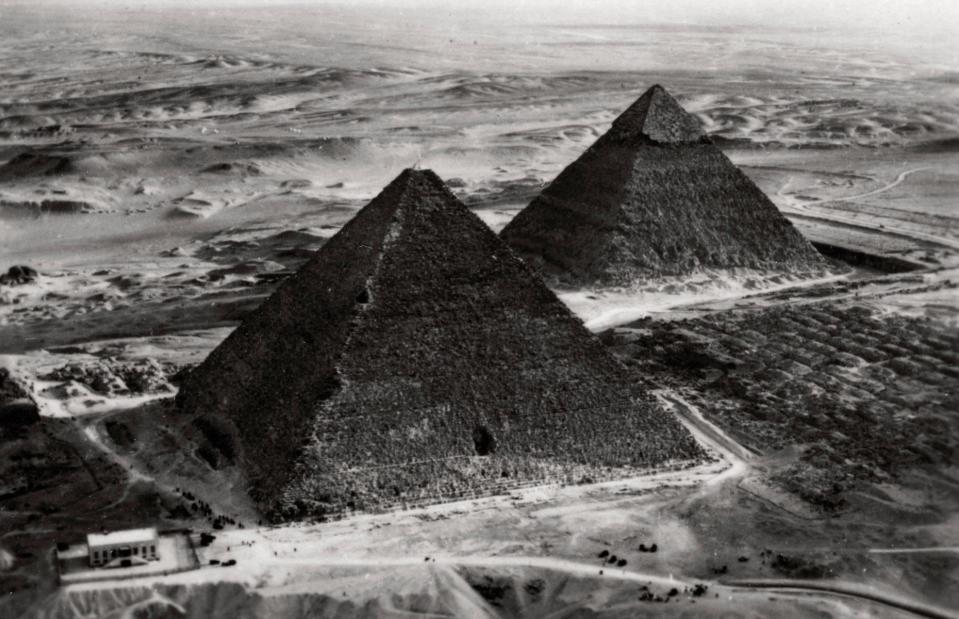
Print Collector/Getty Images
So much research focuses on how the pyramids were built, that it's easy to forget about the why. The three pyramids were tombs for their respective pharaohs – 'death residences' that were intended to be indestructible and eternal.
Each pyramid was once kitted out with grave goods intended to help the deceased into the afterlife, almost all of which were stolen long before the advent of archaeology. Each pyramid was also part of a complex – usually an associated temple and causeway – which became places of worship after the burial was complete.
Priests would leave offerings to the deceased kings – a spiritual boon for the priests in this world, and for the kings in the next.
Pyramid-building had fallen out of favour by the New Kingdom
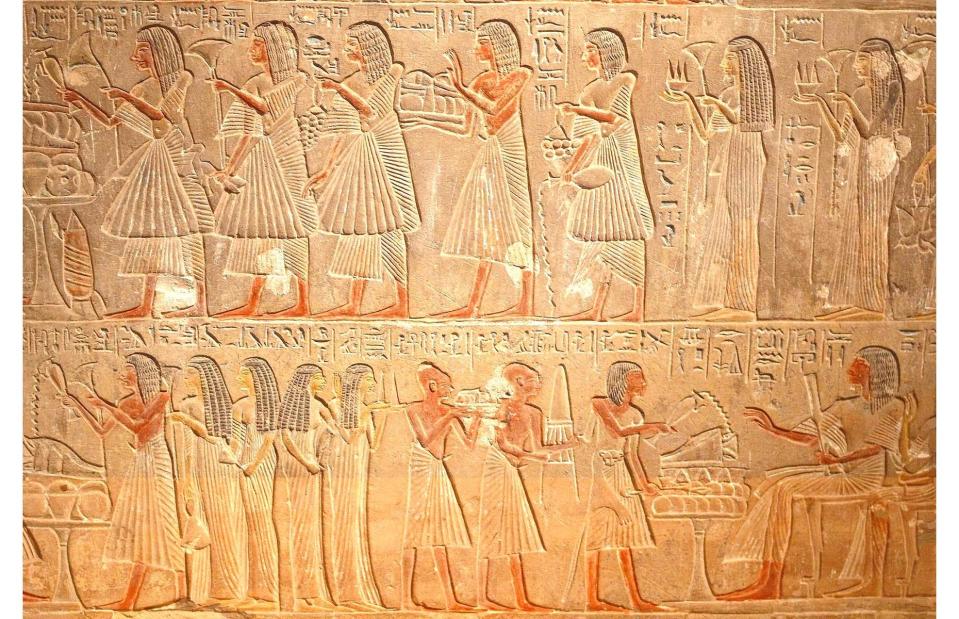
ingehogenbijl/Shutterstock
Ancient Egyptian history is usually divided into three great ages: the Old Kingdom (around 2686-2181 BC), the Middle Kingdom (about 2025-1795 BC) and the New Kingdom (about 1550-1069 BC). The last pharaoh to actually build a royal pyramid was Ahmose I, the first ruler of the New Kingdom, at the royal necropolis in Abydos – today just a pile of rubble.
Exactly why pyramid-building ceased we can't be sure – perhaps they were too easy to plunder – but use of the Giza complex continued through the New Kingdom. Several pharaohs including Tutankhamun added temples and other structures to the site, but royal burials now took place in lavishly decorated underground tombs.
Herodotus visited in the 450s BC
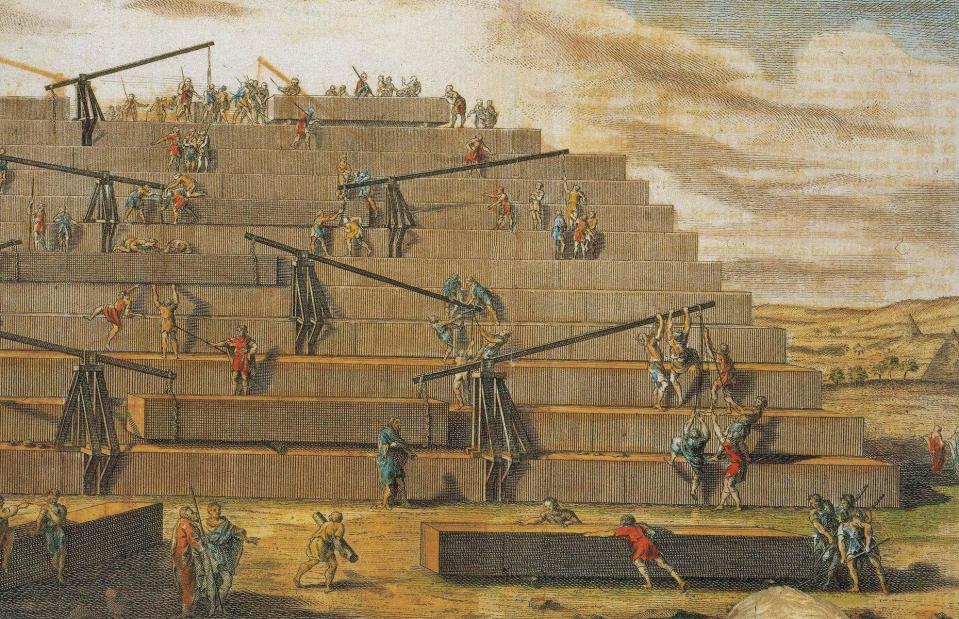
Science History Images/Alamy Stock Photo
Widely dubbed 'the father of history', Greek writer and geographer Herodotus was the world's first historian and was blown away by the pyramids when he visited in the 450s BC, by which time the two-millennia-old monuments were already ancient curiosities. He wrote that each pyramid took a team of 100,000 workmen 20 years to complete, lifting the blocks up the pyramid's tiers with large wooden cranes.
Herodotus wrote evocatively and at impressive length, but we can't always trust him. He also wrote that the Persian king kept a team of enormous subterranean ants, the size of large dogs, that he used to dig for gold.
The Muslim caliphs were equally impressed
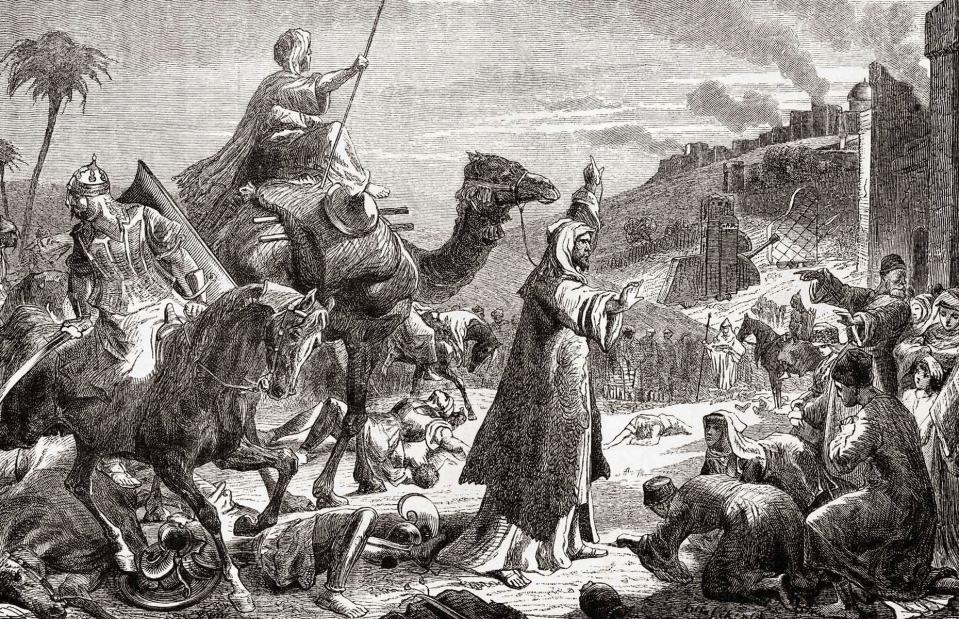
Classic Image/Alamy Stock Photo
Egypt was conquered by Alexander the Great in 332 BC and by the Romans in 30 BC, but it was the Arab conquests of the 7th century AD that left the largest legacy. The armies of Caliph Umar nabbed Egypt from the ailing Eastern Roman Empire in AD 641, and quickly converted it to the new Muslim religion.
The pyramids have been part of the Islamic world ever since, and quickly fascinated Arab rulers, scientists and scholars, who correctly deciphered several hieroglyphic symbols. One story claims that Caliph Ma'mun ordered his men to tunnel into the Great Pyramid in AD 820, becoming the first humans inside in more than 3,000 years.
Though one tried to destroy them
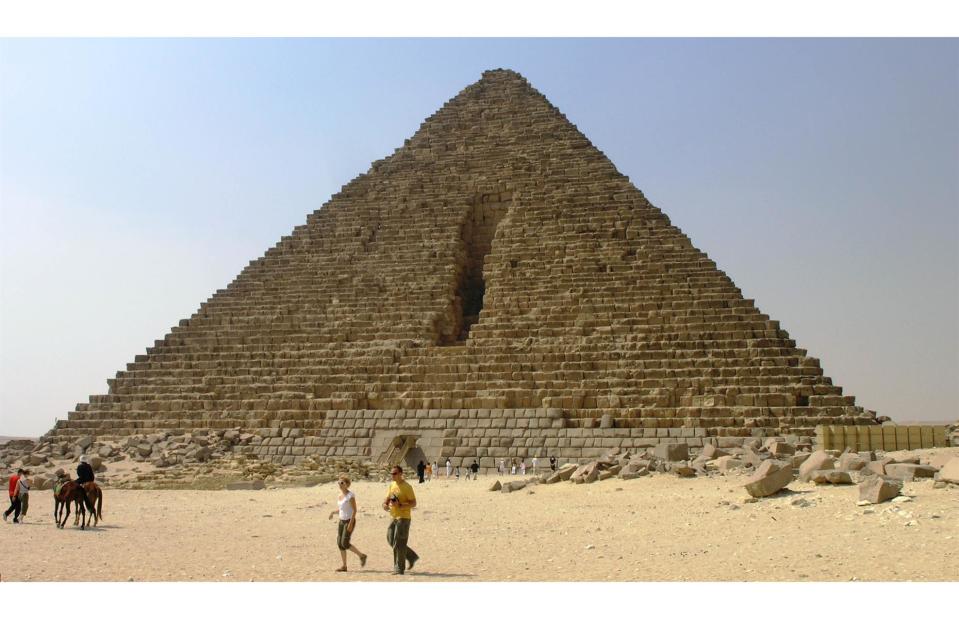
Daniel Mayer/Wikimedia Commons/CC BY-SA 4.0
Not every Arab ruler was so impressed. In the 12th century Egypt's Ayyubid sultan Al-Aziz Uthman ordered that the pyramids be torn down – possibly for religious reasons, possibly to use the stone elsewhere. He soon discovered that giant piles of two-and-a-half-tonne rocks are not so easily destroyed.
His labourers and stonemasons reportedly spent eight months making a small dent in the Menkaure Pyramid before the sultan admitted defeat, realising that demolishing the pyramids could be just as challenging as putting them up. The gash his workers left in the side of the pyramid is still clearly visible today.
Looting and grave-robbing stripped them bare
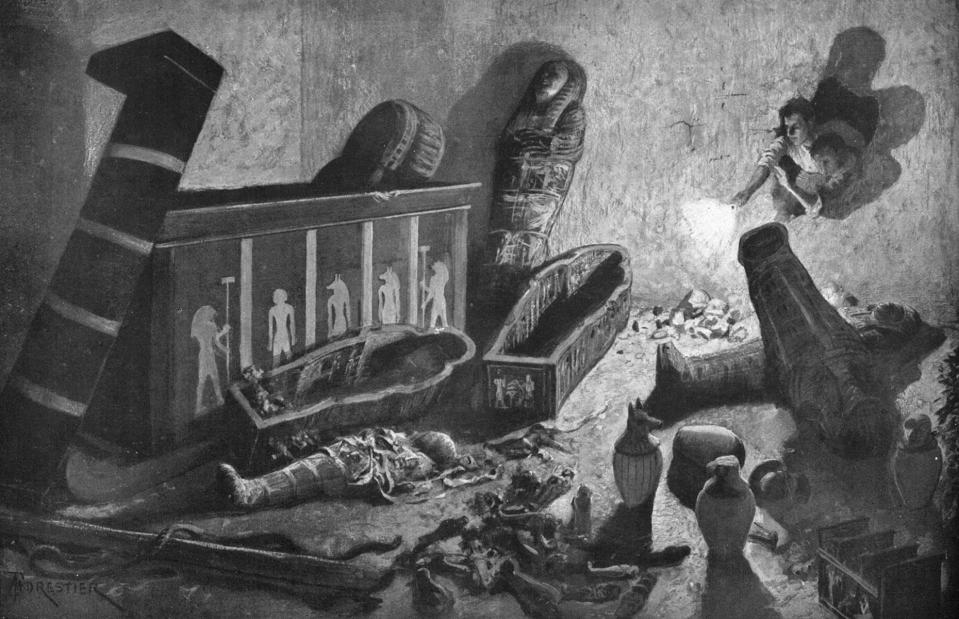
Print Collector/Getty Images
Grave-robbing is perhaps more associated with ancient Egypt than any other civilisation, and images of hooded vandals with burning torches breaking into mysterious rooms full of riches untouched for millennia have lived long in the popular imagination. In reality, grave-robbing was mostly done by the ancient Egyptians themselves, and Giza's pyramids were probably fully looted within a few centuries of their construction.
The so-called Dixon Relics, found by British engineer Waynman Dixon, remain the only significant artefacts to have been found inside the Great Pyramid: a copper hook, a dolerite ball and a piece of cedar.
Napoleon won the so-called 'Battle of the Pyramids'
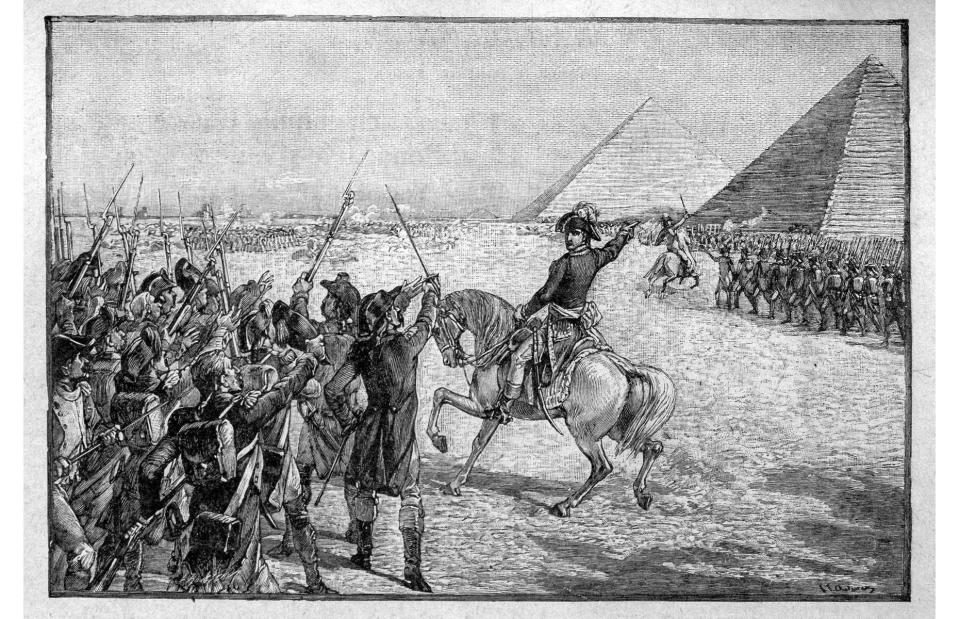
agefotostock/Alamy Stock Photo
Richard Nixon, Winston Churchill, Kourtney Kardashian – the pyramids have had their share of high-profile visitors, but it's French general Napoleon Bonaparte whose name is still indelibly linked with them. He didn't, as it is often said, shoot the nose off the Sphinx, nor did he spend a night alone in the King's Chamber.
Nor did he, as the recent Ridley Scott Napoleon film would have you believe, order his troops to turn their cannons on the monuments themselves. But he did crush a Mamluk-Ottoman army in 1798 at the Battle of the Pyramids – fought within sight of the Great Pyramid – and his deputies did make a series of important discoveries, including unearthing the Rosetta Stone.
Egypt gained international attention
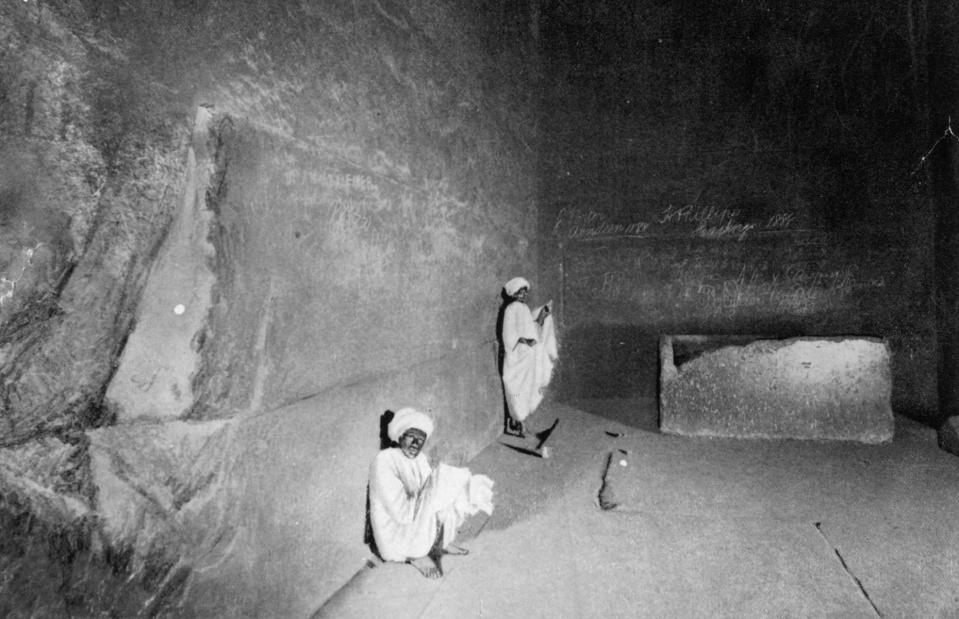
Spencer Arnold Collection/Getty Images
Napoleon's discoveries in Egypt – and particularly the 23-volume Description de l'Egypte produced by his scholars – helped kickstart a wave of 'Egyptomania', a fascination with all things ancient Egypt that thrived in 19th-century Europe and America. Egypt as a subject of study (Egyptology) took off too, and Italian explorer Giovanni Caviglia made early inroads in 1817 by entering the Great Pyramid's inner chambers and fully uncovering the Sphinx.
Sadly Caviglia did irreparable damage to the pyramids by blasting openings with dynamite.
Egyptology became a fashionable pursuit
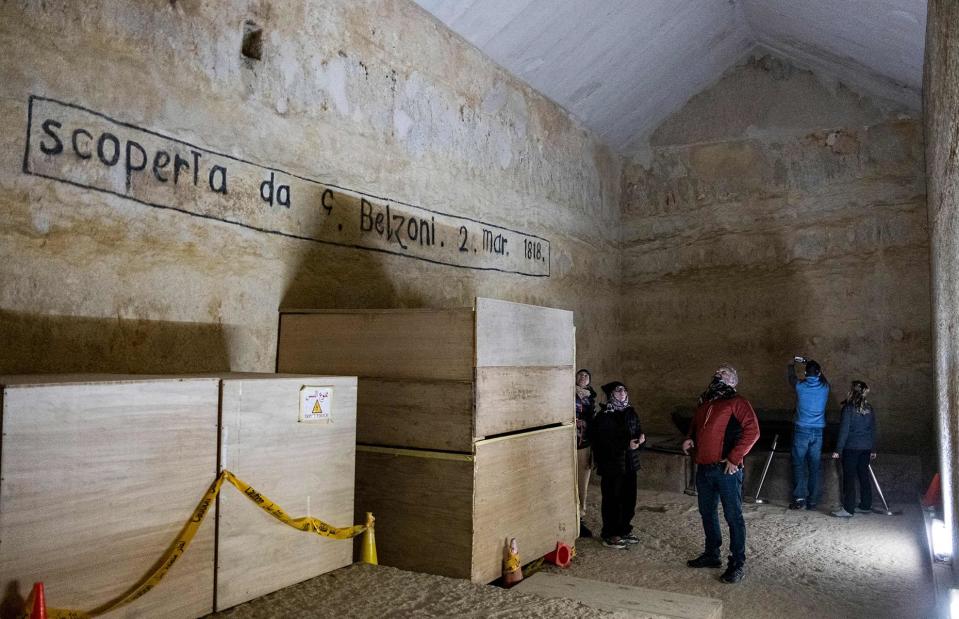
AMIR MAKAR/Getty Images
Two years later, former circus strongman Giovanni Belzoni became the first modern Egyptologist to enter the burial chamber of the Khafre Pyramid. He found Arabic graffiti that long predated his arrival, and promptly added his own to the chamber wall (pictured here).
Hieroglyphics were finally fully deciphered in the 1820s, and in the 1830s British Egyptologist Howard Vyse found inscriptions in the Great Pyramid that named Khufu as its patron and beneficiary. Vyse and his team also conducted a detailed survey of the Menkaure Pyramid – although again, today his liberal use of dynamite is an extremely uncomfortable detail.
Egyptology has attracted criticism
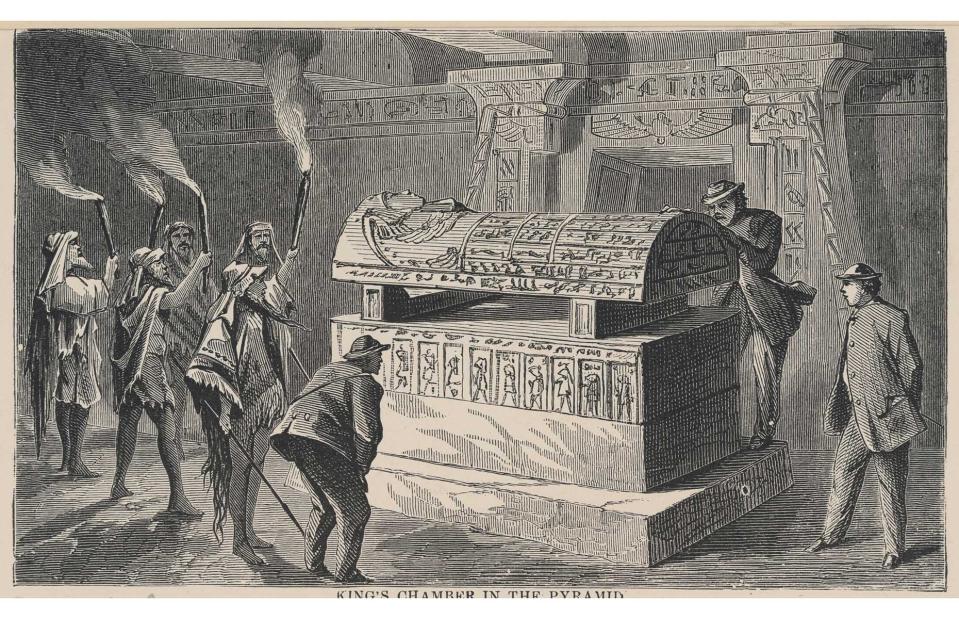
Bettmann/Getty Images
Through the late 19th and early 20th centuries Egyptology slowly formalised, and the Egyptian Antiquities Service was set up to administer who was digging where. Although it was certainly in Egypt, it was initially far from Egyptian, and it was not until 1928 that Selim Hassan became the first local scholar to be made a professor of Egyptology at the University of Cairo.
In modern times, traditional Egyptology has been strongly criticised for Eurocentrism – and for its explosive methodology.
The pyramids were an allied barracks during the First World War
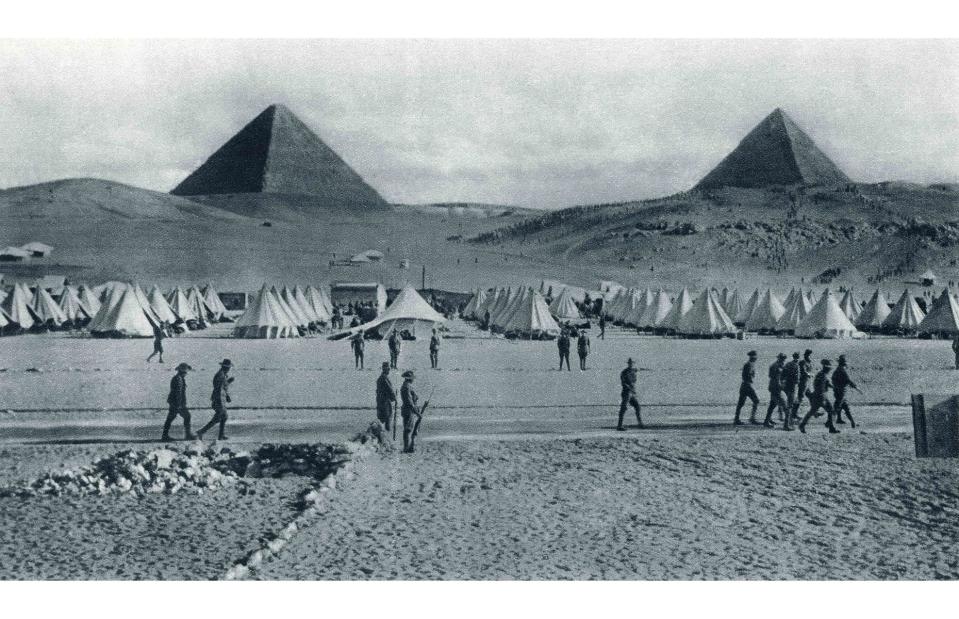
Print Collector/Getty Images
Napoleon's Egyptian ambitions had been ended by British admiral Lord Nelson at the Battle of the Nile in 1798, but international conflict returned to the pyramids a little over a century later. By the start of the First World War, Egypt was occupied by the British and a steady stream of allied Australian and New Zealand troops filed into the country in 1914.
Many of the Australian troops were based at Mena Camp (pictured), where they underwent training in the twin shadows of the pyramids of Khufu and Khafre. Many of the men never returned to camp, let alone their native lands, as their divisions bore the brunt of the disastrous Gallipoli campaign, waged in 1915.
Upper-class tourism started in the 19th century
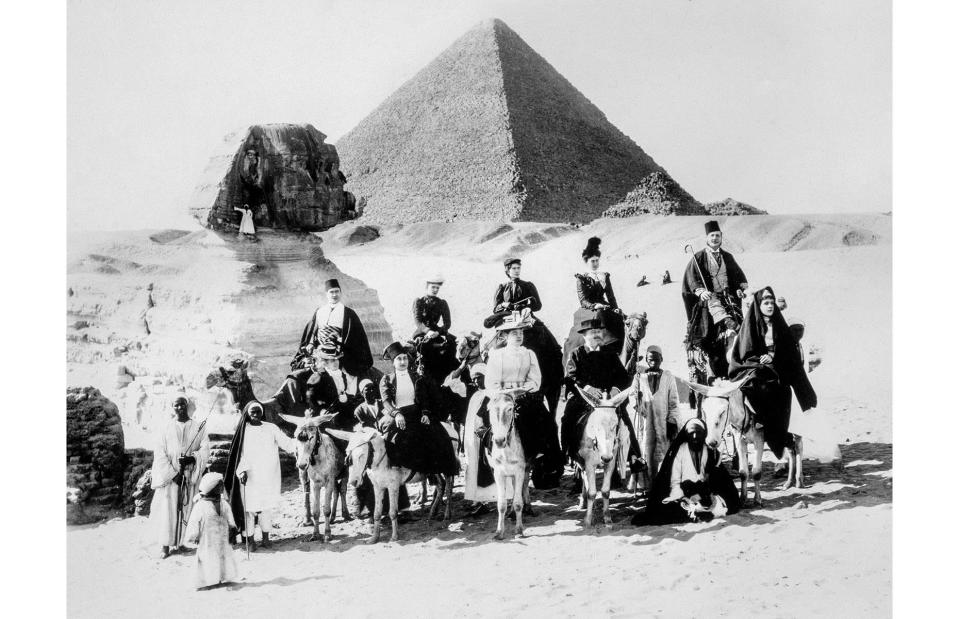
Hirarchivum Press/Alamy Stock Photo
Tourism as a concept really developed through the 19th century, and the Suez Canal became a gateway to Egypt for upper-class travellers when it opened in 1869. It was in that same year that pioneering British travel entrepreneur Thomas Cook escorted his first tour group to Egypt and Palestine.
The trip included a cruise up the Nile, and within a few years would include a visit to the pyramids in its itinerary. Climbing the Great Pyramid was perfectly legal well into the 20th century, and early tour groups would sunbathe and take tea at the top.
Egyptomania spiked again with Howard Carter's discovery of Tutankhamun's tomb in 1922, and the pyramids shot to the top of many a bucket list.
The pyramids have become a magnet for conspiracy
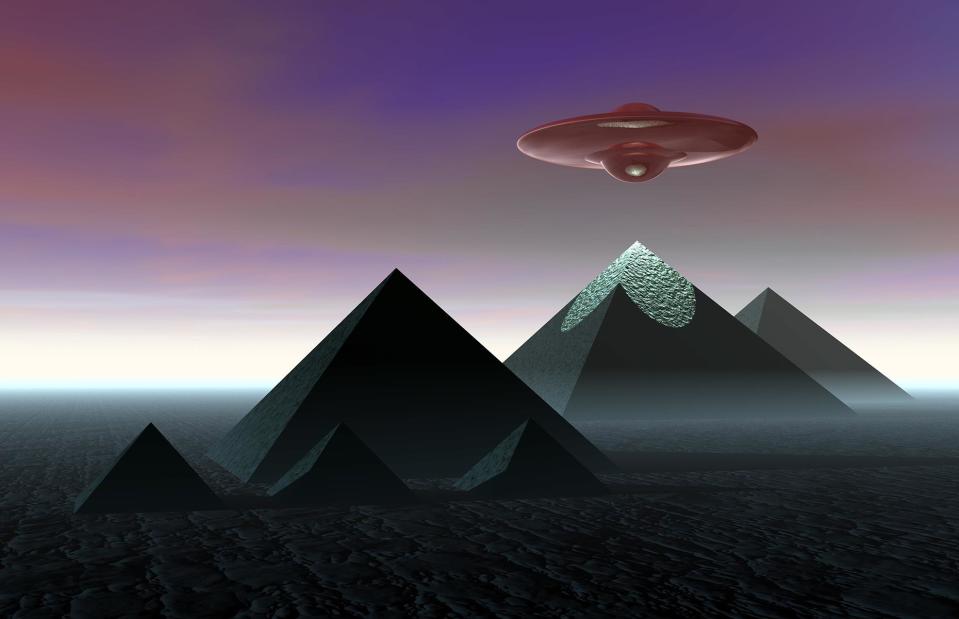
Vladimir Zadvinskii/Shutterstock
Pyramid-related pseudo-science and conspiracism has been so common down the decades that it even has its own word: pyramidology. The pyramids are so old, so mysterious and so seemingly ahead of their time that they've become a lightning rod for strange origin myths and stories of mystical properties.
Some say they possess geometric qualities that accurately predict historical and religious events, others that they were built by a super-advanced civilisation that vanished long ago – the people of Atlantis perhaps. But the most popular pyramidological theory by far is that they were built by aliens.
Most Egyptologists do not agree.
Air travel and mass tourism changed the game
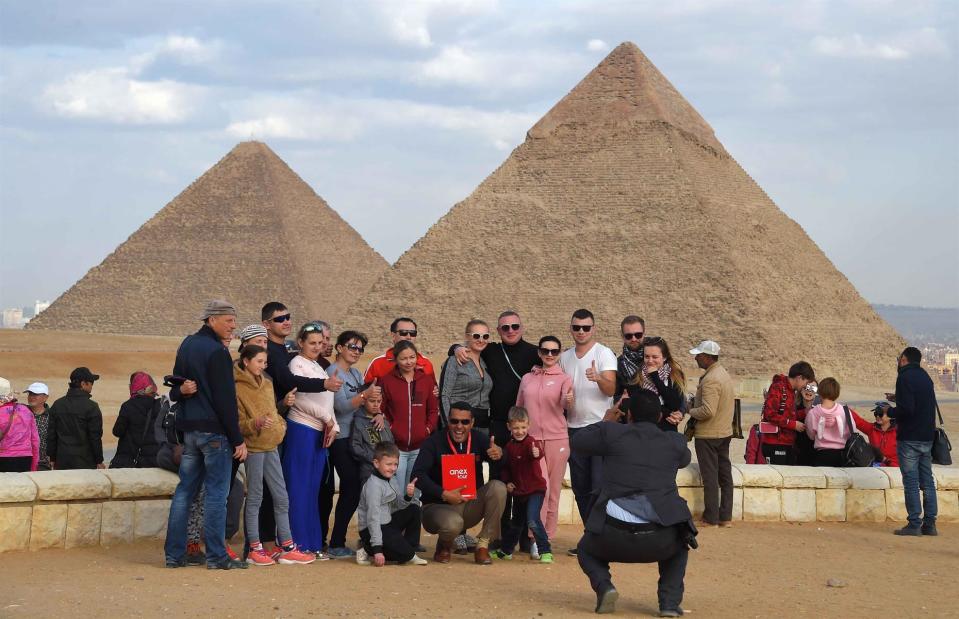
MOHAMED EL-SHAHED/Getty Images
The advent of mass tourism in the 1960s and 1970s transformed destinations across the globe. Though estimates vary, in the early 1950s visitors to Egypt hovered around the 100,000 a year mark, while at its peak in 2010 the country welcomed 14 million foreign arrivals, generating US$13 billion of GDP.
Political instability saw visitor numbers plummet over the following decade, but they rebounded strongly to 11.7 million in 2022. Not all these visitors swung by Giza's pyramids, but given the site's dominance on postcards and guidebook covers, you can reasonably assume that many did.
The pyramids are now used for art and culture...
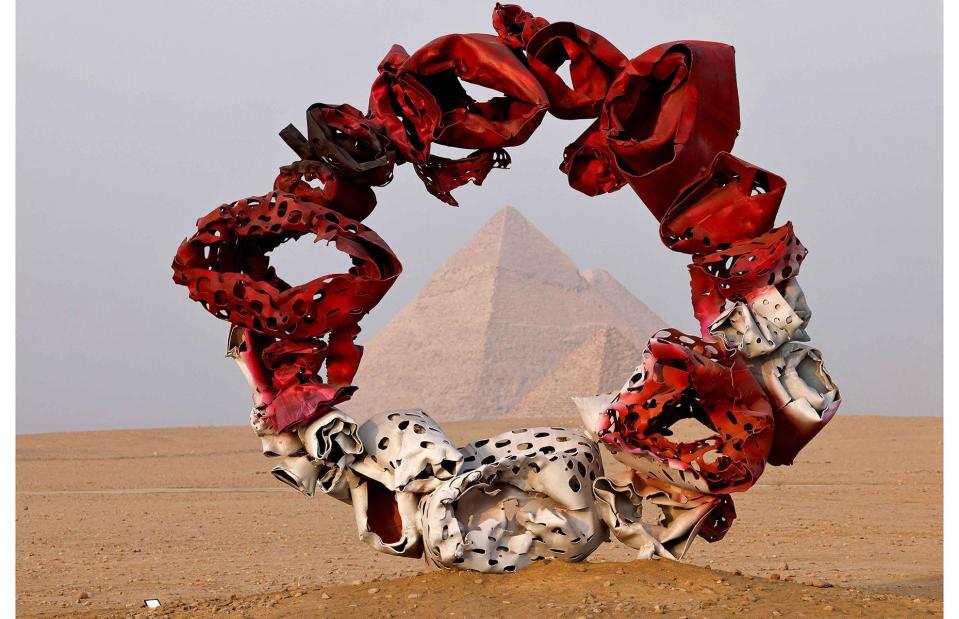
KHALED DESOUKI/Getty Images
In recent years, the pyramids have found new purpose as a concert hall and exhibition space. In 2023 the 'Forever Is Now' international art exhibition opened on the Giza Plateau for its third iteration, showcasing monumental outdoor works ranging from sleek, modern statues of ancient goddesses to a floating gold triangle that seemed to turn the pyramids on their heads.
And ever since rock band the Grateful Dead shook the storied stones with back-to-back concerts in 1978, the 'Live at the Pyramids' stage has showcased acts like Frank Sinatra (1979), Sting (2001) and Mariah Carey (2010), all the way through to Maroon 5 in 2022.
...and sometimes for politics
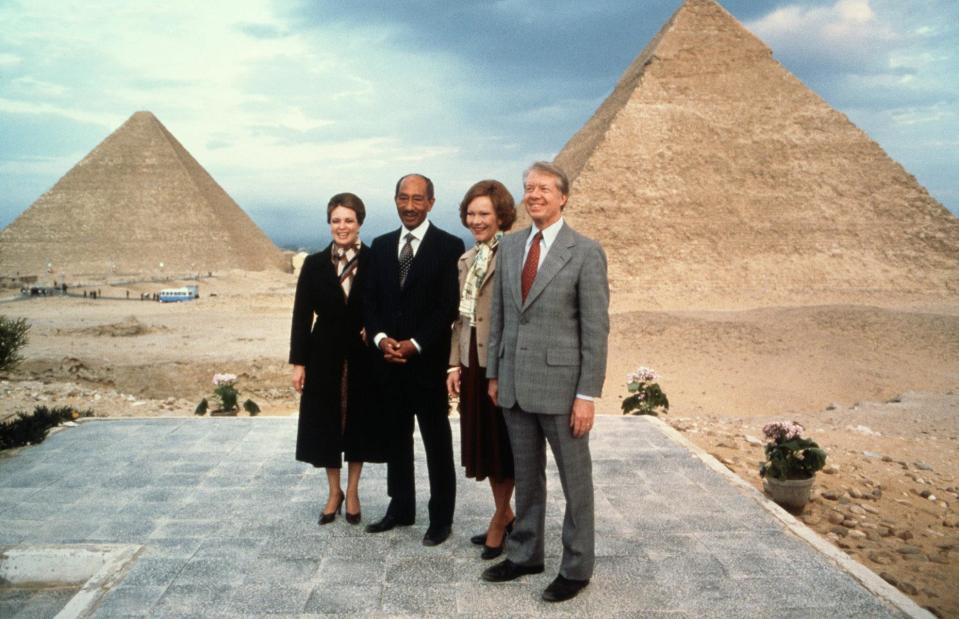
Wally McNamee/Getty Images
Arguably Egypt's crown jewels, the pyramids are also wheeled out for much-photographed tours with foreign dignitaries. In 1862 the Prince of Wales, later King Edward VII, scaled the great pyramid, describing the climb as "rather serious and difficult".
Former US president Bill Clinton came in 2002, Russian leader Vladimir Putin visited in 2005 and Indian Prime Minister Narendra Modi was shown around during a state visit to Egypt in 2023. Pictured here in 1979 is then-US president Jimmy Carter with then-Egyptian premier Anwar Sadat, and their respective wives.
New discoveries are still being made
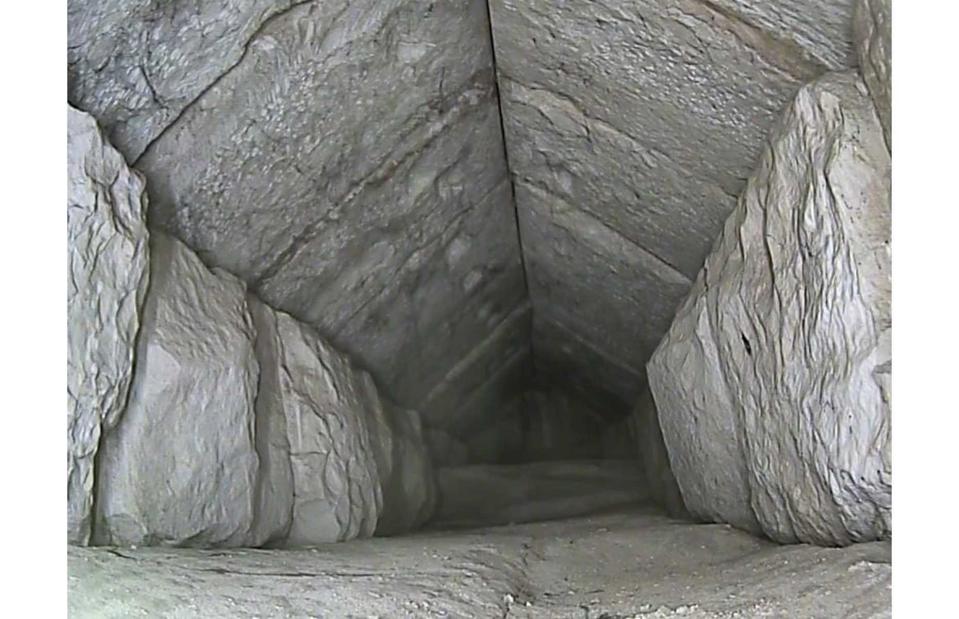
Egyptian Ministry of Antiquities
You'd be forgiven for thinking that the most famously old monument on Earth might have given up all its secrets by now, particularly since it's one of history's most studied buildings. But in early 2023 new hi-tech scanning equipment made a startling discovery in the Great Pyramid – an unknown tunnel above the main entrance, undisturbed for millennia.
The 30-foot-long (9m) and six-feet-wide (2m) passage can't be accessed from outside, and this photo was taken by feeding a minuscule camera through cracks in the masonry. No one knows what it was used for, but it seems Egyptologists can rest assured that these astonishing, perplexing pyramids still have secrets to reveal.
Now discover the mysterious story of Bodie, America's eeriest ghost town

